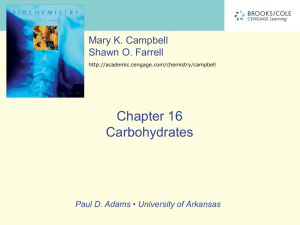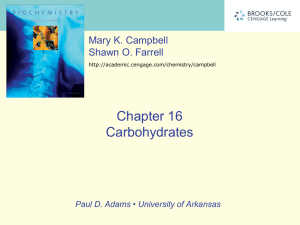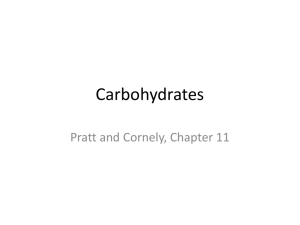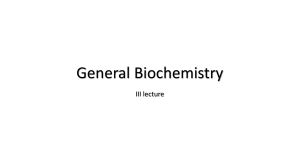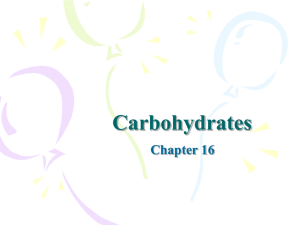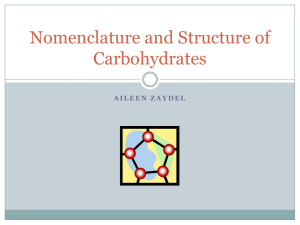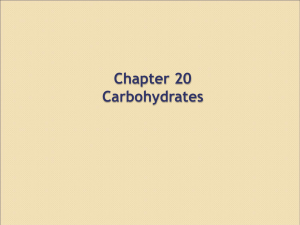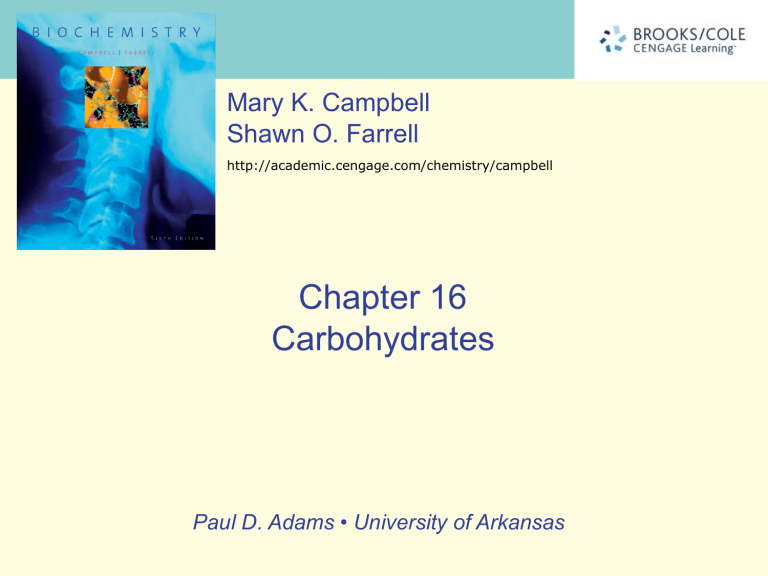
Mary K. Campbell Shawn O. Farrell http://academic.cengage.com/chemistry/campbell Chapter 16 Carbohydrates Paul D. Adams • University of Arkansas Carbohydrates • Carbohydrate: a polyhydroxyaldehyde or polyhydroxyketone, or a substance that gives these compounds on hydrolysis • Monosaccharide: a carbohydrate that cannot be hydrolyzed to a simpler carbohydrate • Building blocks of all carbohydrates • They have the general formula CnH2nOn, where n varies from 3 to 8 • Aldose: a monosaccharide containing an aldehyde group • Ketose: a monosaccharide containing a ketone group Monosaccharides • Monosaccharides are classified by their number of carbon atoms • Trioses are simplest carbohydrate monosaccharides • Glyceraldehyde contains a stereocenter and exists as a pair of enantiomers • Mirror-images stereoisomers are called enantiomers Fischer Projections • Fischer projection: bonds are written in a two dimensional representation showing the configuration of tetrahedral stereocenters • horizontal lines represent bonds projecting forward • vertical lines represent bonds projecting to the rear • the carbon atom at the intersection of the horizontal and vertical lines is not shown D,L Monosaccharides • According to the conventions proposed by Fischer • D-monosaccharide: a monosaccharide that, when written as a Fischer projection, has the -OH on its penultimate carbon on the right • L-monosaccharide: a monosaccharide that, when written as a Fischer projection, has the -OH on its penultimate carbon on the left Aldotetroses • Enantiomers: stereoisomers that are mirror images • example: D-erythrose and L-erythrose are enantiomers • Diastereomers: stereoisomers that are not mirror images • example: D-erythrose and D-threose are diastereomers Stereoisomers of Aldotetroses Stereochemical Relationships Between Monosaccharides What Happens if a Sugar Forms a Cyclic Molecule? • Cyclization of sugars takes place due to interaction between functional groups on distant carbons, C1 to C5, to make a cyclic hemiacetal • Cyclization using C2 to C5 results in hemiketal formation. • In both cases, the carbonyl carbon is new chiral center and becomes an anomeric carbon Formation of a Cyclic Hemiacetal Cyclic Structure • Monosaccharides have -OH and C=O groups in the same molecule and exist almost entirely as five- and six-membered cyclic hemiacetals • anomeric carbon: the new stereocenter resulting from cyclic hemiacetal formation • anomers: carbohydrates that differ in configuration only at their anomeric carbons The Three Forms of Glucose Haworth Projections • Haworth projections • five- and six-membered hemiacetals are represented as planar pentagons or hexagons, as the case may be, viewed through the edge • most commonly written with the anomeric carbon on the right and the hemiacetal oxygen to the back right • the designation b- means that -OH on the anomeric carbon is cis to the terminal -CH2OH; a- means that it is trans Haworth Projections (Contʼd) • A six-membered hemiacetal ring is shown by the infix -pyran- (pyranose) • A five-membered hemiacetal ring is shown by the infix -furan- (furanose) • Five-membered rings are so close to being planar that Haworth projections are adequate to represent furanoses • For pyranoses, the six-membered ring is more accurately represented as a strain-free chair conformation Haworth Projections (Contʼd) Comparison of the Fischer and Haworth Representations Reaction of Monosaccharides • Reducing sugar: one that reduces an oxidizing agent • Oxidation of a cyclic hemiacetal form gives a lactone • When the oxidizing agent is Tollens solution, silver precipitates as a silver mirror • If anomeric carbons are involved in glycosidic linkage, there will be a negative Tollens reagent test • If another anomeric carbon is not bonded and is free, there will be a positive Tollens reagent test Reaction of Monosaccharides (Contʼd) • The carbonyl group of a monosaccharide can be reduced to an hydroxyl group by a variety of reducing agents, such as NaBH4 • reduction of the C=O group of a monosaccharide gives a polyhydroxy compound called an alditol Phosphoric Esters • Phosphoric esters are particularly important in the metabolism of sugars to provide energy • phosphoric esters are frequently formed by transfer of a phosphate group from ATP Glycosidic Bond Formation • Glycoside: a carbohydrate in which the -OH of the anomeric carbon is replaced by -OR • those derived from furanoses are furanosides; those derived from pyranoses are pyranosides • glycosidic bond: the bond from the anomeric carbon to the -OR group • This is the basis for the formation polysaccharides/oligosaccharides Glycosidic Bond Formation (Contʼd) Two Different Disaccharides of a-DGlucose • Glycosidic linkages can take various forms; the anomeric carbon of one sugar to any of the -OH groups of another sugar to forma an a- or bglycosidic linkage Amino Sugars Amino Sugars • Sugars with an amino group at C-2 are amino sugars. They are found in many oligosaccharides and polysaccharides Muramic acid •component of cell membranes of higher organisms and bacterial cell walls •a glycosamine linked to a 3-carbon acid at C-3. Sialic acids Two depictions of a sialic acid. Some Important Oligosaccharides • Sucrose Table sugar; obtained from the juice of sugar cane and sugar beet One unit of D-glucose and one unit of D-fructose joined by an a-1,2-glycosidic bond • Lactose Made up of D-galactose and one unit of D-glucose joined by a b-1,4-glycosidic bond Galactose is a C-4 epimer of glucose • Maltose Two units of D-glucose joined by an a-1,4-glycosidic bond Formed from the hydrolysis of starch Differs from cellobiose by the conformation of the glycosidic linkage Some Important Disaccharides A Variety of Higher Oligosaccharides Occur in Nature Oligosaccharides occur widely as components of antibiotics (derived from various sources). Figure 7.19 Erythromycin is an antibiotic produced by a strain of Streptomyces erythreus. Figure 7.19 Streptomycin is an oligosaccharide produced by Stretomyces griseus. • • • • • • Cellulose the major structural component of plants, especially wood and plant fibers a linear polymer of approximately 2800 D-glucose units per molecule joined by b-1,4-glycosidic bonds fully extended conformation with alternating 180° flips of glucose units extensive intra- and intermolecular hydrogen bonding between chains Starch • • • a polymers of a-D-glucose units amylose: continuous, unbranched chains of up to 4000 a-D-glucose units joined by a-1,4-glycosidic bonds amylopectin: a highly branched polymer consisting of 24-30 units of D-glucose joined by a-1,4-glycosidic bonds and branches created by a-1,6-glycosidic bonds Amylose and Amylopectin Dextrans A small but significant difference from starch and glycogen • If you change the main linkages between glucose from alpha(1,4) to alpha(1,6), you get a new family of polysaccharides - dextrans • Branches can be (1,2), (1,3), or (1,4) • Dextrans formed by bacteria are components of dental plaque • Dextrans in plaque presumably provide protection for oral bacteria • Cross-linked dextrans are used as "Sephadex" gels in column chromatography Chitin • • major structural component of the exoskeletons of invertebrates, such as insects and crustaceans; also occurs in cell walls of algae, fungi, and yeasts composed of units of N-acetyl-b-D-glucosamine joined by b-1,4-glycosidic bonds Agarose • a component of agar obtained from marine red algae, is a chain of alternating D-galactose and 3,6-anhydro-L-galactose. • agarose gels are used in laboratories to separate biomolecules on the basis of size Plant Cell Walls • consist largely of cellulose • also contain pectin which functions as an intercellular cementing material • pectin is a polymer of D-galacturonic acid joined by a-1,4glycosidic bonds Bacterial Cell Walls • prokaryotic cell walls are constructed on the framework of the repeating unit NAM-NAG joined by b-1,4-glycosidic bonds Glycoproteins • contain carbohydrate units covalently bonded to a polypeptide chain • oligosaccharide portion of glycoproteins act as antigenic determinants (example blood group substances) Glycosaminoglycans • Glycosaminoglycans: polysaccharides based on a repeating disaccharide where one of the monomers is an amino sugar and the other has a negative charge due to a sulfate or carboxylate group • Heparin: natural anticoagulant, a very high negative charge • Hyaluronic acid: a component of the vitreous humor of the eye and the lubricating fluid of joints • Chondroitin sulfate and keratan sulfate: components of connective tissue (tendons, cartilage) • Dermatan sulfate is a component of the extracellular matrix of skin • Glycosaminoglycans are constituents of proteoglycans Glycosaminoglycans – Linear Chains of Repeating Disaccharides linear chains of repeating disaccharides in which one unit is an amino sugar and one or both is negatively charged. Proteoglycans • • • • • glycoproteins whose carbohydrates are mostly glycosaminoglycans components of the cell membrane and the glycocalyx (a “sugar shell” around the cell) typically consist of proteins with one or two types of glycosaminoglycan Modulation of cell growth processes Cushioning in joints: cartilage matrix proteoglycans absorb large amounts of water. During joint movement, cartilage is compressed, expelling water
